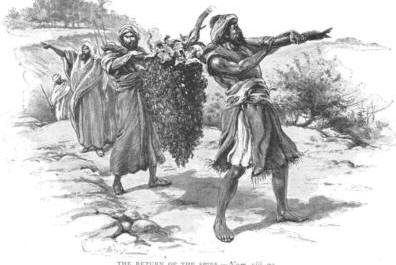
The number ten resonates deeply within the Torah, symbolizing Divine order and completeness. From creation’s ten utterances to Abraham’s trials, Canaan’s scouts, and the Mishkan’s curtains, this article studies the profound presence of the number ten in Jewish tradition and spirituality.
Criticism of the Promised Land by the Tribes
In the Book of Numbers, specifically Parashat Shelach Lecha (Chapter 13), the Israelites approached Moses with a request: to send skilled individuals to scout their ancestral land. These scouts were tasked with gathering critical insights—population size, living conditions, the state of Canaan’s cities and fortifications, and the fertility of the land.
Each tribe, except for the Levites, chose one representative, forming a group of twelve. For forty days, they explored the land of Canaan. The group returned to the camp of Bnei Yisrael, bringing back with them a vivid testament to the land’s bounty: a massive cluster of grapes carried on their shoulders with two wooden poles, along with pomegranates and figs from the region.
During their report, only two individuals—Joshua son of Nun and Caleb son of Jephunneh—spoke positively about the land, describing it as “a land flowing with milk and honey”. The remaining ten spies, however, criticized the land and spread a negative view. Their words incited fear and panic among the children of Israel, leading the people to consider returning to Egypt.
This response angered God, and He declared a punishment for the people. As detailed later in the Parasha (Chapter 14, Verses 20–23 and 30–34):
- 20. And the Lord said, “I have forgiven them in accordance with your word
- However, as surely as I live, and as the glory of the Lord fills the earth…
- 22. that all the people who perceived My glory, and the signs that I performed in Egypt and in the desert, yet they have tested me these ten times and not listened to My voice,
- if they will see the Land that I swore to their fathers, and all who provoked Me will not see it.
- You shall [not] come into the Land concerning which I raised My hand that you would settle in it, except Caleb the son of Jephunneh and Joshua the son of Nun.
- As for your infants, of whom you said that they will be as spoils, I will bring them [there], and they will come to know the Land which You despised.
- But as for you, your corpses shall fall in this desert.
- Your children shall wander in the desert for forty years and bear your defection until the last of your corpses has fallen in the desert.
- According to the number of days which you toured the Land forty days, a day for each year, you will [thus] bear your iniquities for forty years; thus you will come to know My alienation.
Names of the Ten Generations from Adam to Noah
- Adam
- Seth
- Enosh
- Kenan
- Mahalalel
- Jared
- Enoch
- Methuselah
- Lamech
- Noah
Names of the Ten Generations from Noah to Abraham
- Shem
- Arpachshad
- Shelah
- Eber
- Peleg
- Reu
- Serug
- Nahor
- Terah
- Abraham (Avinu)
Ten Names of God
Among the seventy-two names of God, ten names begin with the letter Yod (י), which are as follows:
- ילי
- י־ול
- יוי
- ירת
- יחו
- ידז
- ילה
- ייל
- יה
- יב


Ten Non-Domesticated Kosher Animals
Jewish scholars teach that the first step toward achieving spiritual and physical sanctity is refraining from consuming meat. However, every Jew who does eat meat must follow the dietary laws of Kashrut. These laws, outlined in Parashat Shemini, detail the characteristics and names of kosher animals. Furthermore, the Zohar emphasizes that consuming non-kosher meat defiles the body and poisons the soul.
In the Book of Exodus, Parashat Shemini (Chapter 26), it is stated:
Among non-domesticated animals, only ten are considered kosher, and their names are as follows:
- White mountain goat
- Deer
- Gazelle
- Small mountain goat
- Wild goat
- Buffalo
- Bison
- Wild ox
- Long-horned ibex
- African antelope
Furthermore, even the consumption of meat from kosher domesticated and non-domesticated animals is subject to specific regulations.
The Ten Curtains of the Mishkan
In the Book of Exodus, Parashat Terumah (Chapter 26), God commanded the preparation of the Mishkan’s curtains. The Mishkan, also known as the tabernacle or the Tent of the Congregation, was the portable earthly dwelling of God used by the Israelites from the Exodus until the conquest of Canaan. The preparation of the curtains is as follows:
- The Mishkan should be made of finely twisted linen and dyed wool (blue, purple, and crimson), and cherubim figures (angels) should be woven into the fabric on both sides.
- Each curtain must be twenty-eight cubits long and four cubits wide.
- Five of these curtains are combined into one set, and the same is done with the remaining five to create another set.
God instructed Moses to gather offerings from the children of Israel to build the Mishkan, a portable sanctuary for the Divine presence to dwell among the people. The Mishkan was covered with three layers of curtains. The innermost layer featured ten identical curtains crafted from the finest white linen, intricately woven with blue, purple, and crimson wool. These curtains were divided into two sets of five, joined together, and adorned with stunning depictions of cherubim on both sides.
Creation of the World with Ten Divine Utterances
The sages of the Mishnah assert that God created the world through ten utterances. In the Book of Genesis, the first chapter (verses 1-10) illustrates how the act of creation unfolded over six days, emphasizing the ten distinct Divine commands through which the universe was formed.

The Ten Minyan
Kabbalists teach that the completeness of the world is rooted in the number ten, which is intrinsically connected to the ten Sefirot (Divine energies). At every stage of life, humanity must align with these ten principles to foster personal and spiritual growth.
In Jewish tradition, tefillah and certain practices—such as reciting Kaddish, removing the Torah scroll from the ark, burying the dead, performing Brit Milah (circumcision), or observing rituals like Chuppah (marriage) and Birkat HaLevana (blessing of the moon)—require a Minyan, a quorum of ten adult Jewish men, as prescribed by Halakha.
Mystically, each member of a Minyan symbolizes one of the ten Sefirot. Together, they form a complete spiritual assembly, creating a sacred space that connects to higher realms and enables Divine interaction. This alignment with the ten Sefirot generates an atmosphere of sanctity and spiritual wholeness. Achieving this is only possible through the ten Sefirot.
From the very beginning of creation, the symbolic concept of the Minyan has profoundly impacted both the material and spiritual worlds. It has shaped human laws and logic, providing a clear and defined path for humanity to achieve completeness and ultimate fulfillment.
The Ten Tests of Abraham by God
Abraham (Avinu) was tested by God ten times, and in each instance, he passed with unwavering faith. The ten tests were as follows:
- Abraham willingly accepted being cast into a fiery furnace for his beliefs.
- At the age of seventy-five, he left his homeland at God’s command and moved to Eretz Yisrael.
- During his stay in Eretz Yisrael, a famine forced him to journey to Egypt, yet he did not complain or question God’s will.
- Upon entering Egypt, his wife was seized and taken to Pharaoh’s court. Yet, he voiced no complaint or protest. Instead, he turned to God with prayer and heartfelt supplication.
- When his nephew, Lot, was taken captive, Abraham followed God’s will without protest and set out with his servant Eliezer to battle the kings of four nations.
- He accepted without complaint the prophecy that his descendants would endure hardship and oppression under the dominion of various nations.
- At the age of ninety-nine, Abraham circumcised himself in obedience to God’s command, despite his advanced age.
- When Abraham moved to Gerar, his wife was taken from him and brought to the court of Abimelech, the king of the region.
- Following God’s instruction, Abraham divorced Hagar and sent her into the wilderness with her son Ishmael.
- With complete willingness, Abraham agreed to sacrifice his only son, Isaac, as an offering to God.
Sources
- The Holy Scriptures (Torah)
- The Talmud
- Pirkei Avot (Chapters of the [Fore]fathers)
- The Book “Gnajineha-ye Yahudiyat” (Jewish Treasures)
- Notes by David Ravanshenas
- Notes by Joseph Malamed
- Mythological Beliefs by Yosef Setareshenas


 فارسی
فارسی